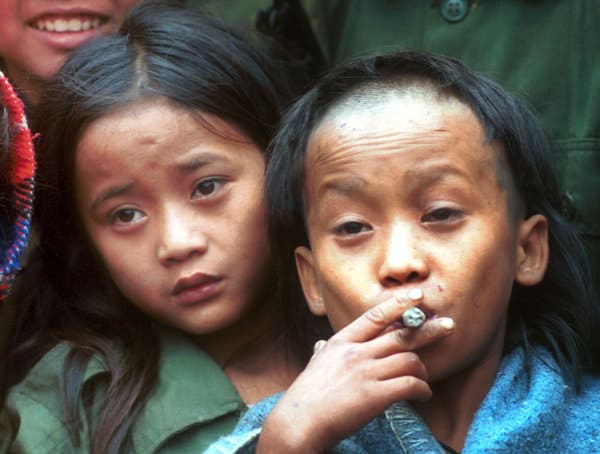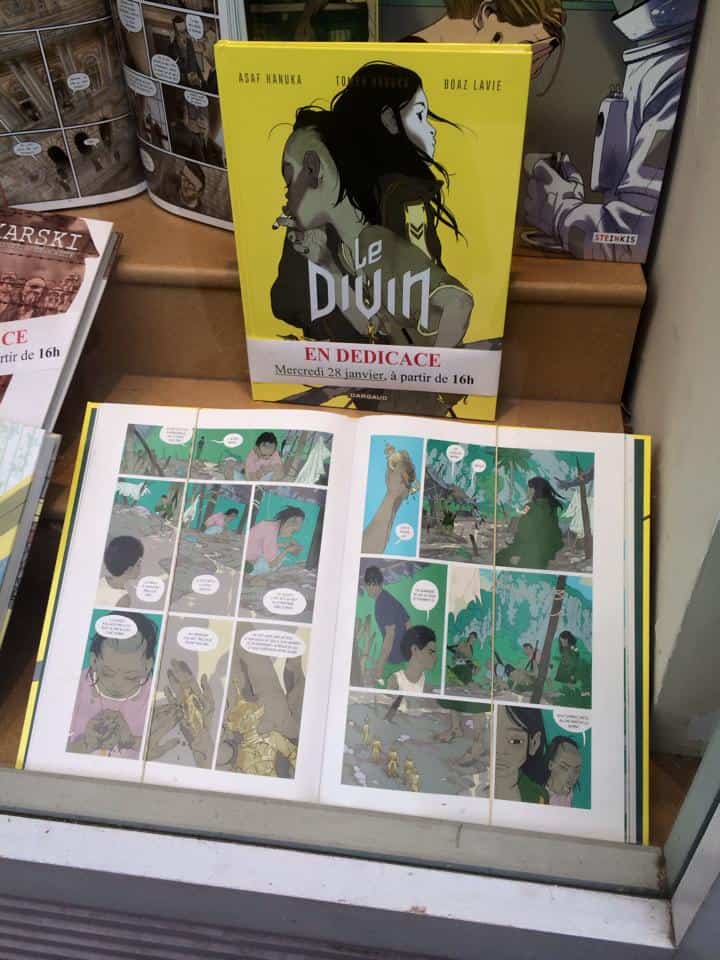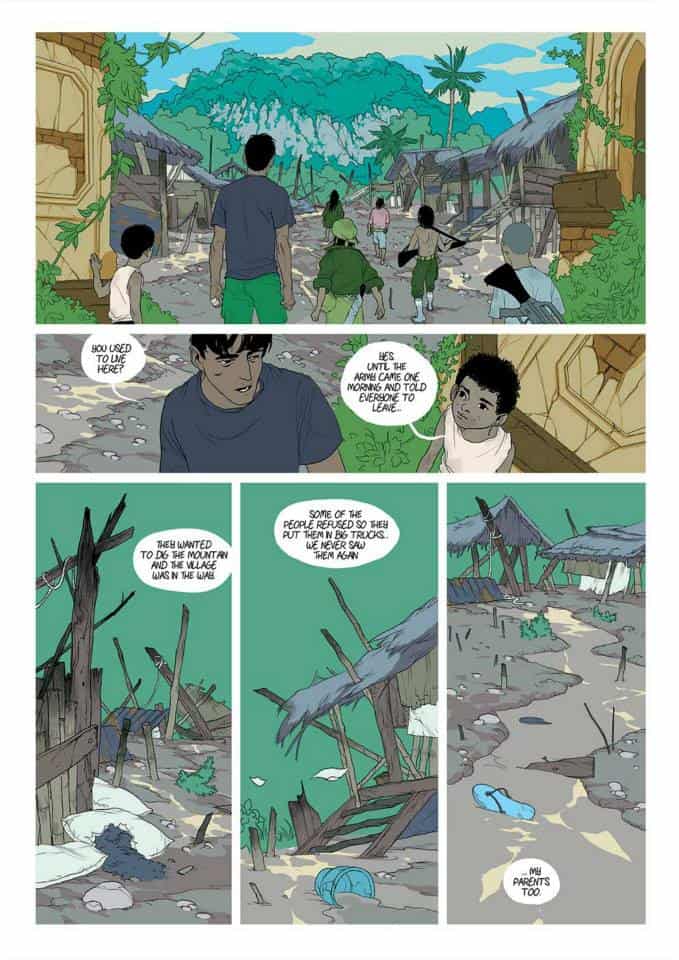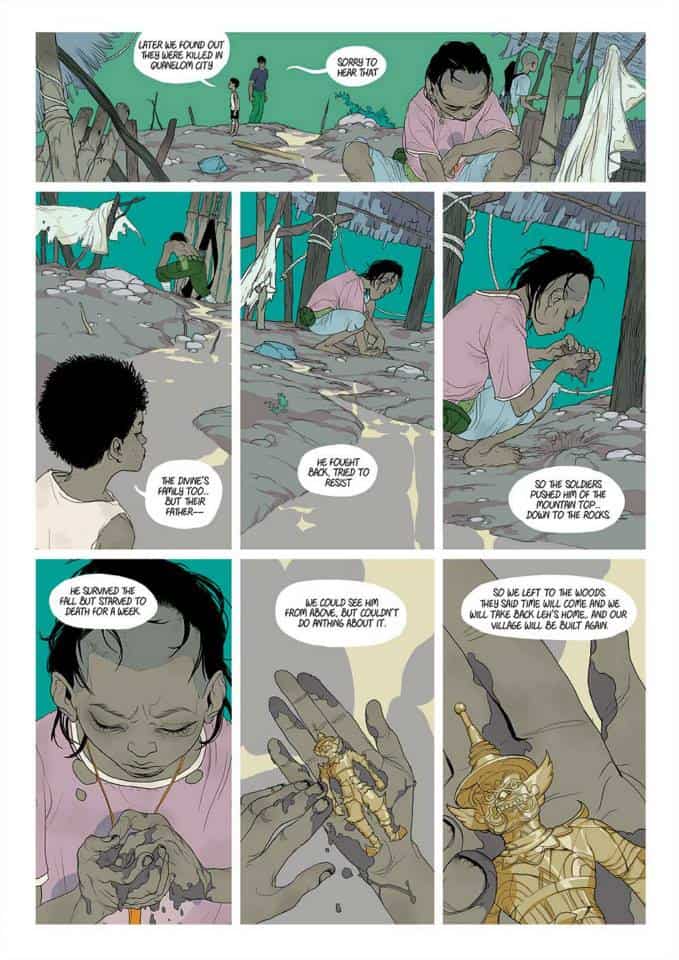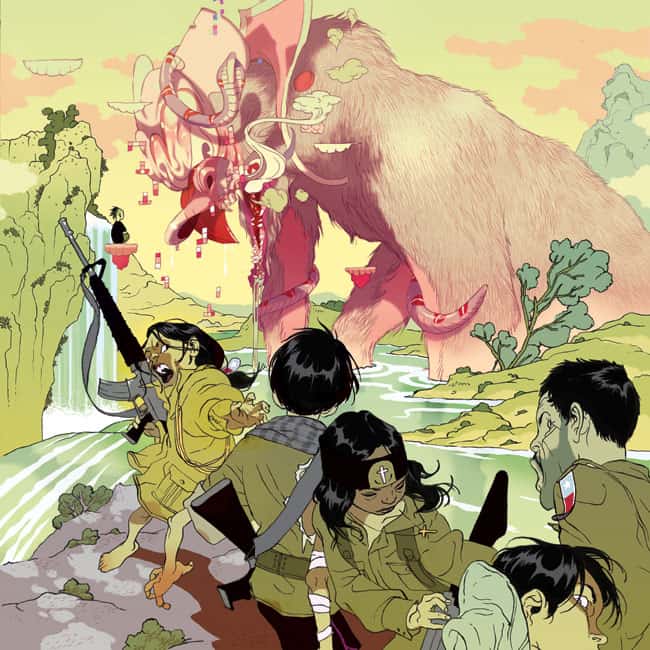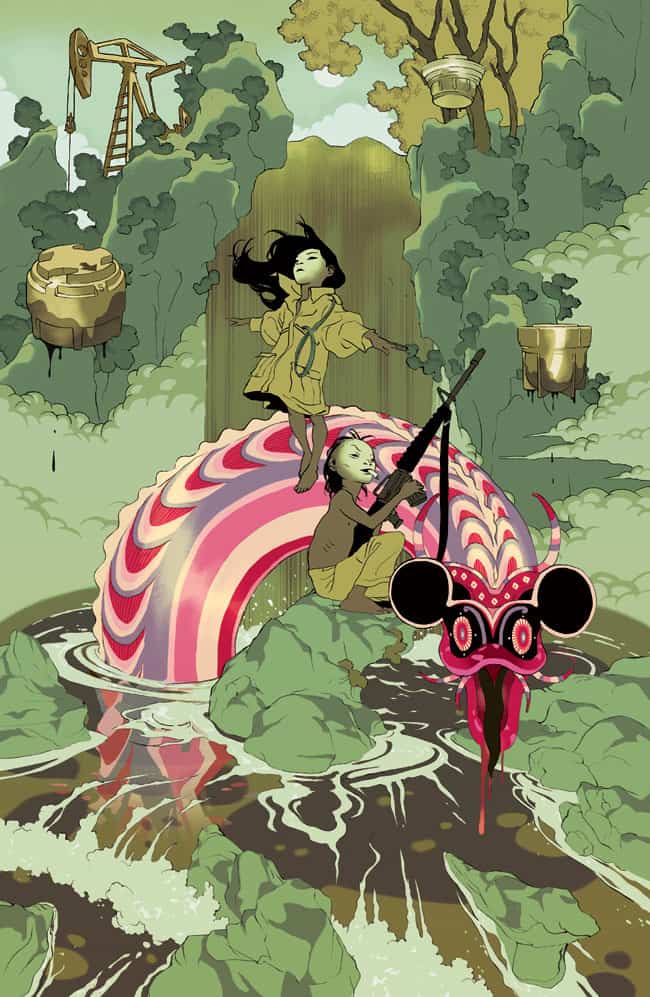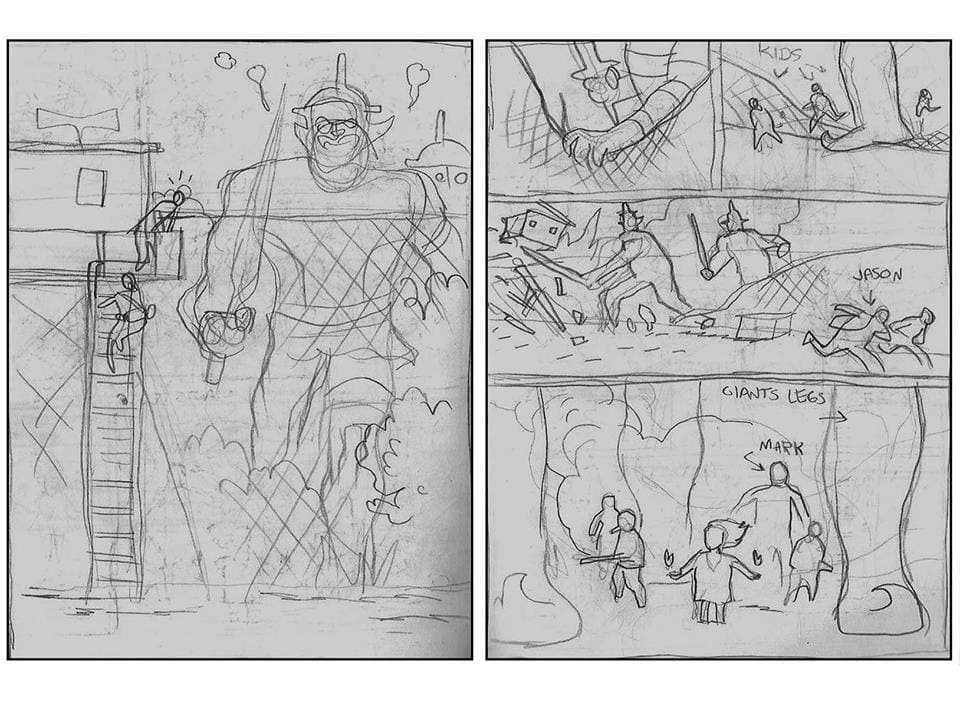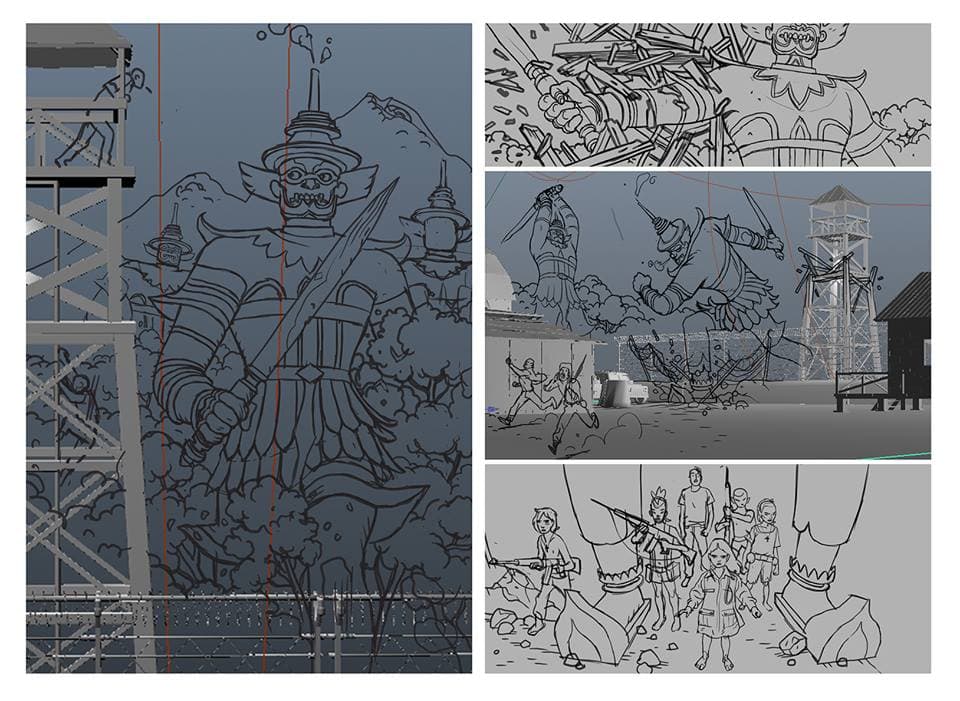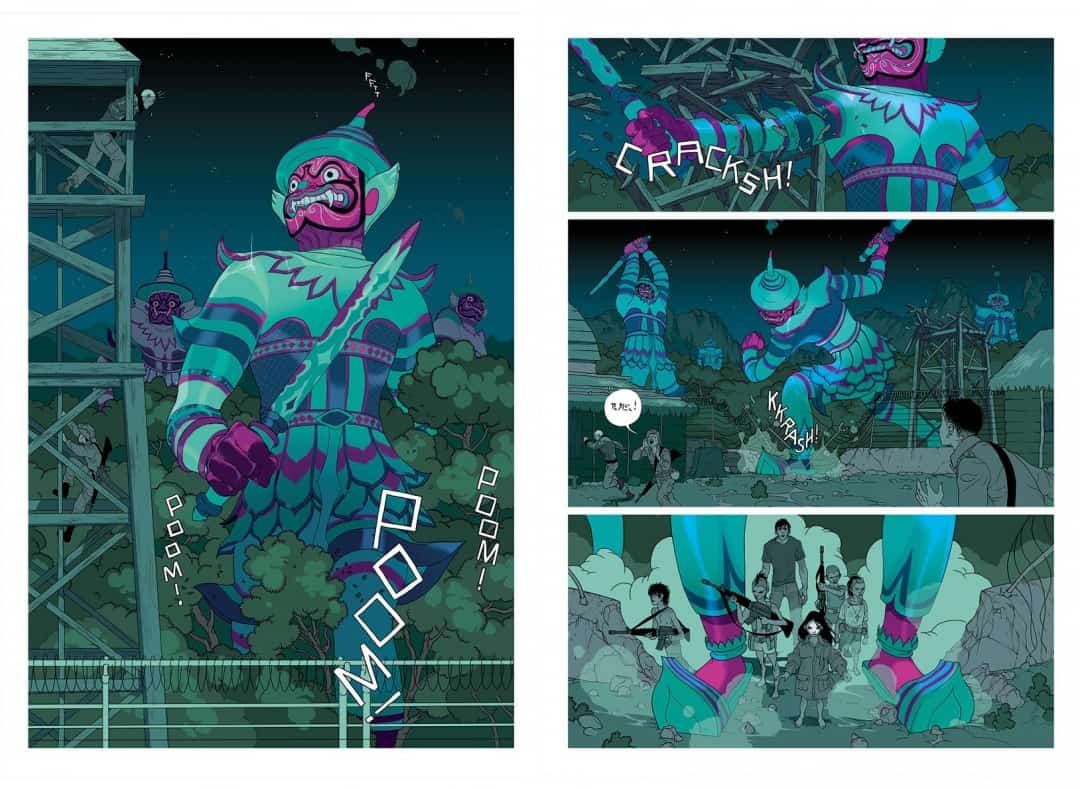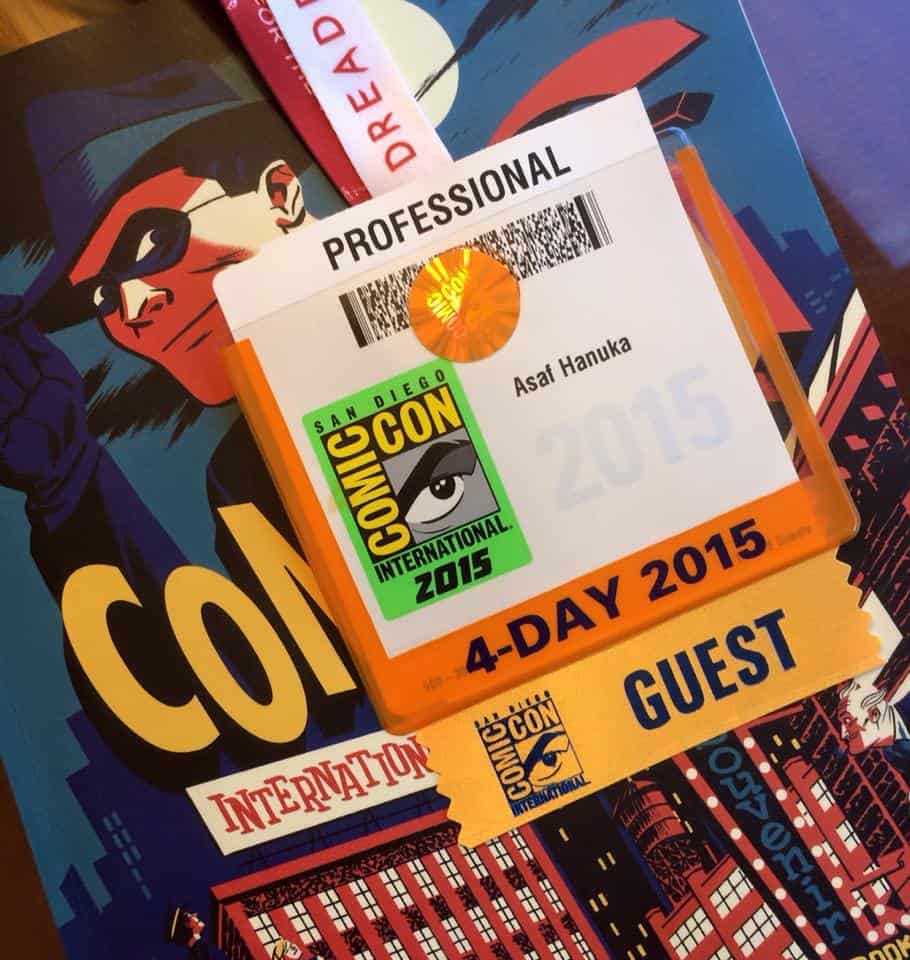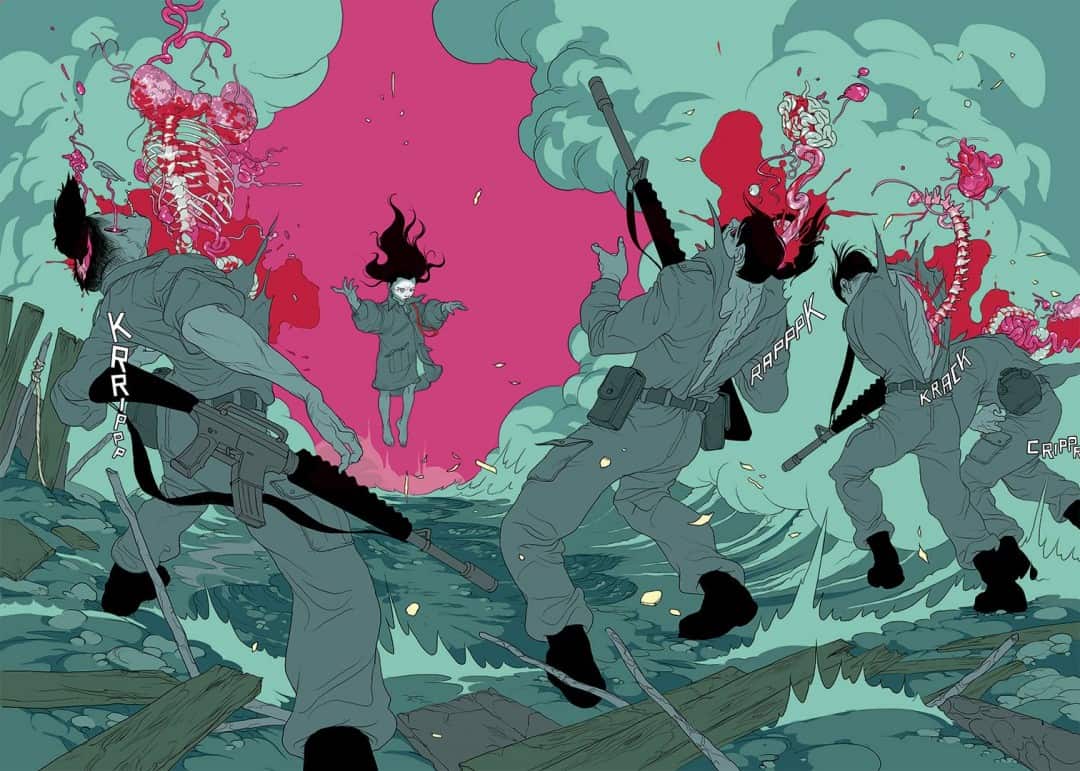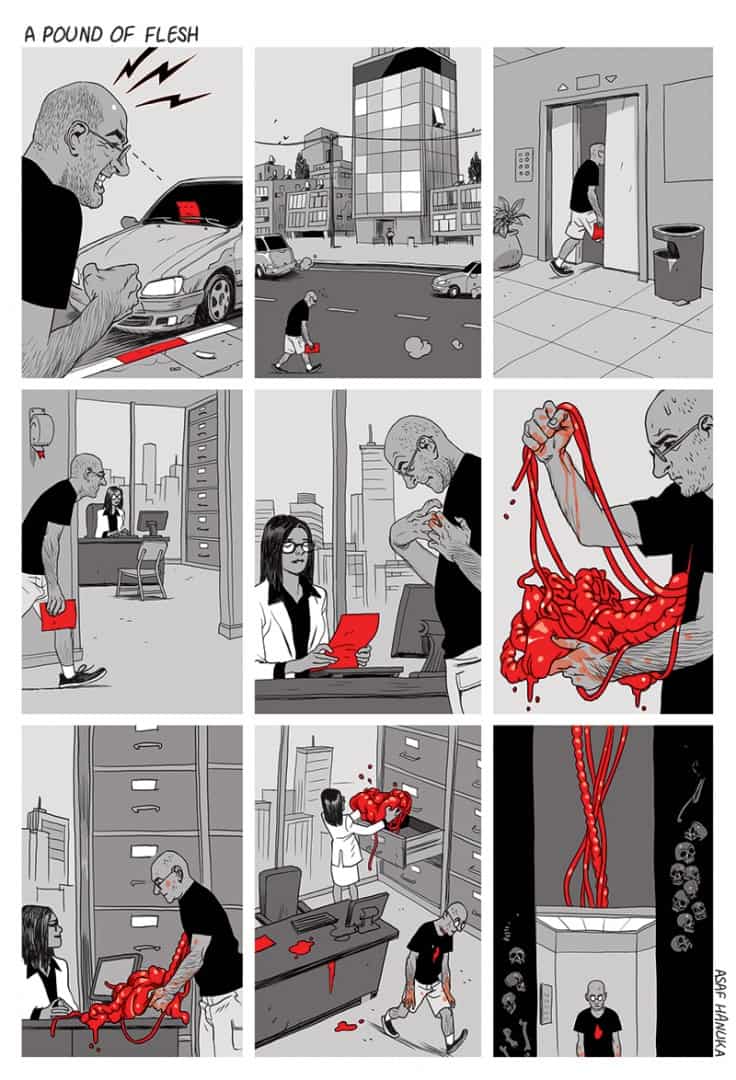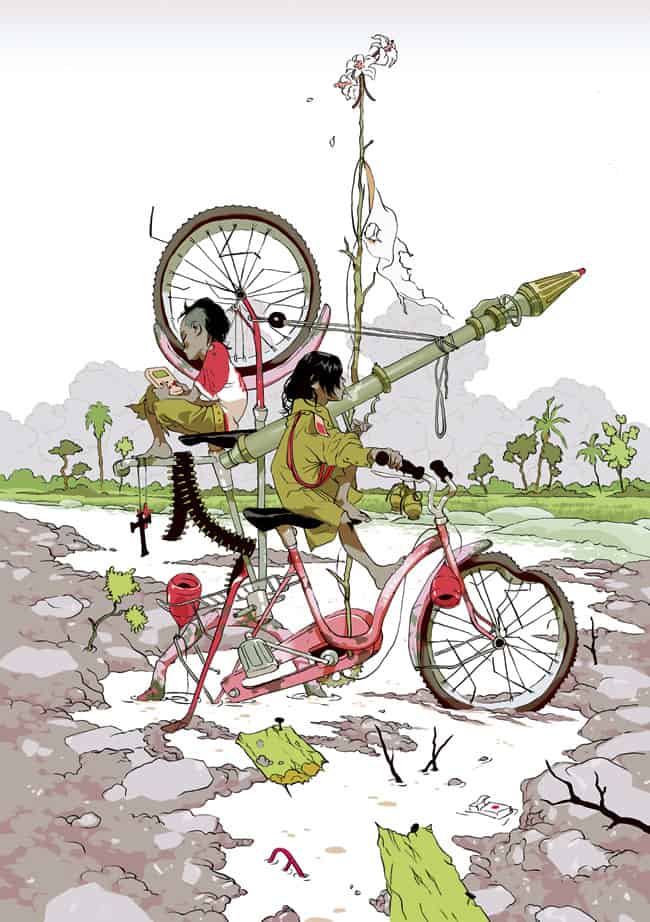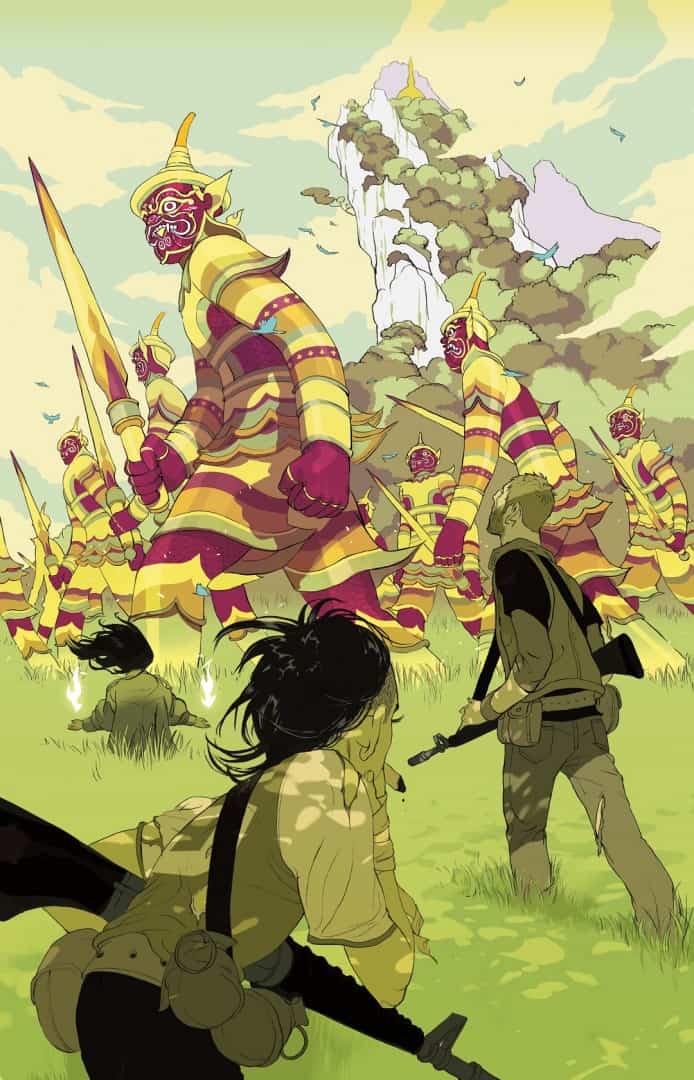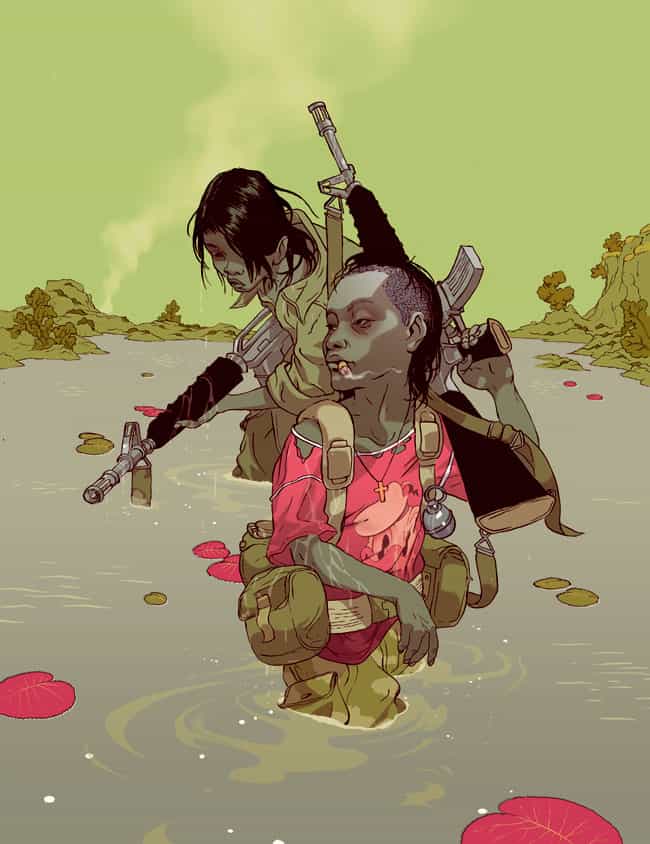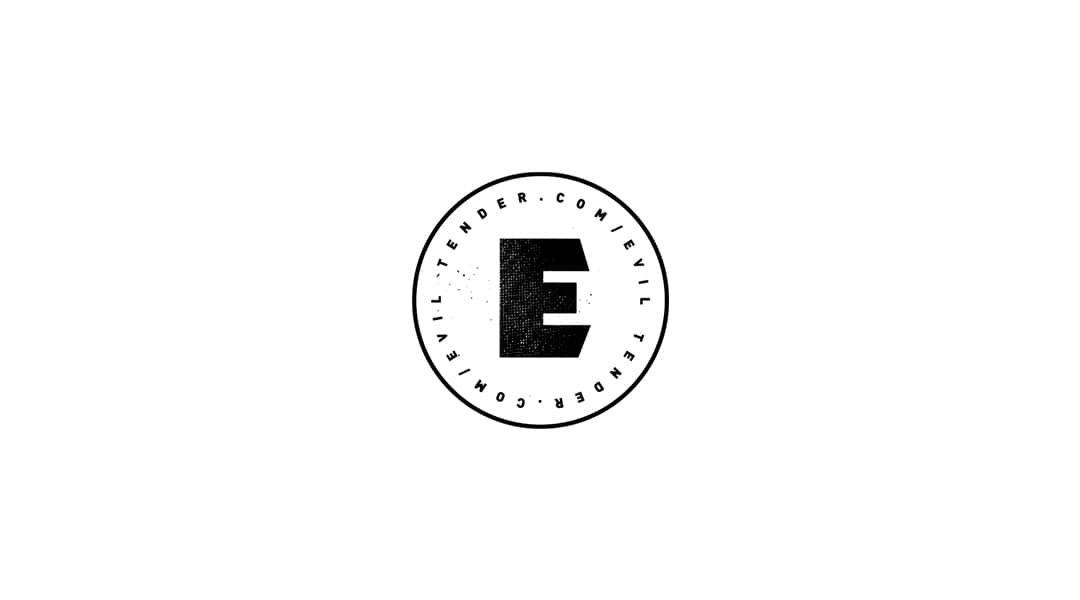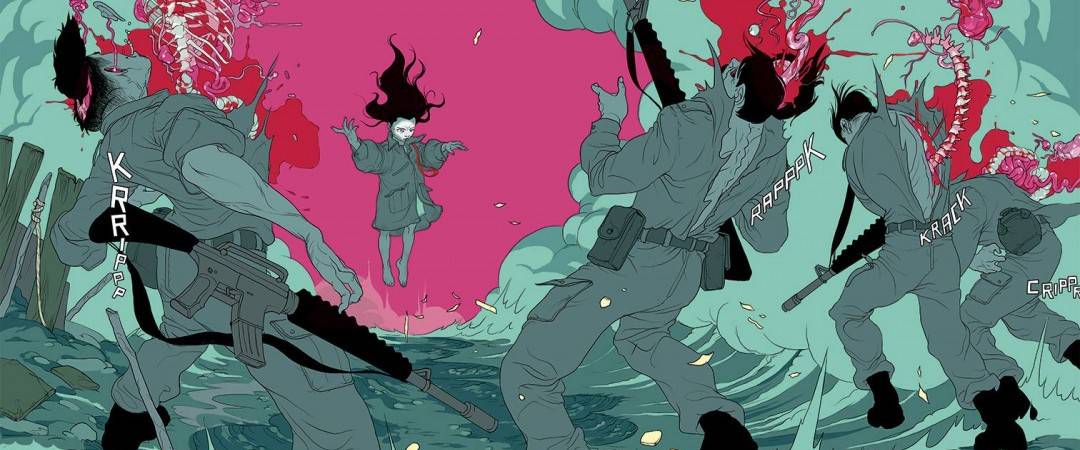
In 2000 a small band of rebel soldiers took a hospital hostage in Ratchaburi, Thailand. Their demand — for the Thai government to stop their bombing of the Karen National Union, a minority group in Burma who had been at war with the Burmese government since 1949 over the creation of independent Karen state.
This event was brought to worldwide attention when a photograph surfaced of Johnny and Luther Htoo, the leaders of God’s Army, the rebel group of over 200 followers behind the hostage situation.
The Htoo twins were 12 years-old at the time.
The story of the Htoo twins is the spark that brought to life the graphic novel ‘The Divine‘ by illustrators Asaf Hanuka, Tomer Hanuka, and writer Boaz Lavie. The book is not a retelling of the Htoo’s time as rebel leaders, but an exploration of youth and maturity, responsibility and power. The book follows American explosives expert Mark, a newly-wed and father-to-be who gets tapped for a black ops mission to the Southeast Asian country of Quanlom. Inside this fictional jungle, Mark rescues an injured young boy — the collateral damage of his mission.
‘The Divine‘ made its premiere stateside in San Diego for Comic Con 2015. Both Asaf Hanuka and Boaz Lavie made the trip out from Tel Aviv and were kind enough to give me a few hours of their time to discuss the book and the long journey it took to finish. The following interview was conducted at the Marriott hotel on July 11, 2015 before Asaf and Boaz spoke at one of their many panels.
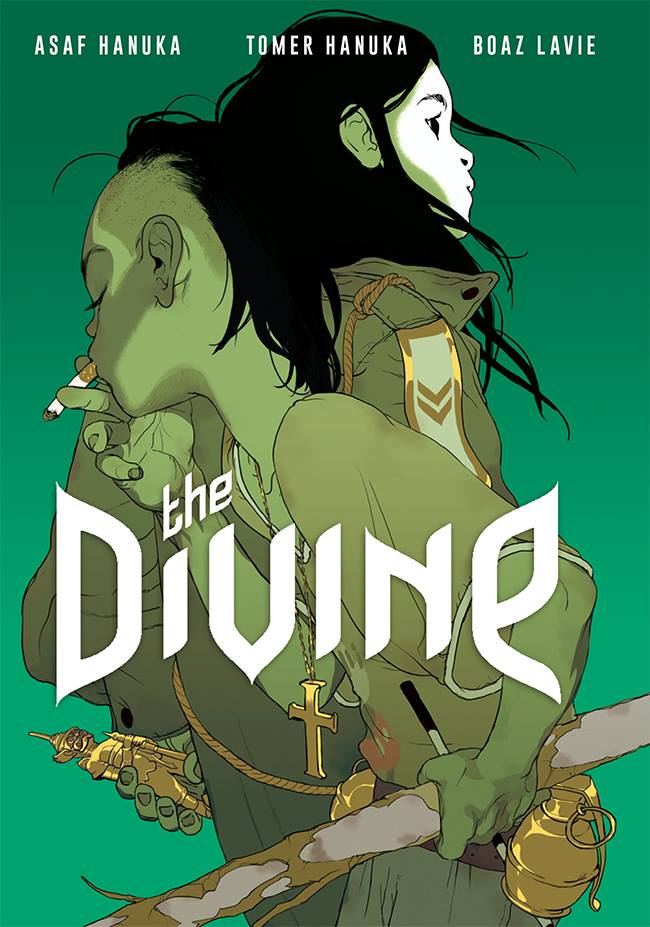
‘The Divine’ by Asaf Hanuka, Tomer Hanuka, and Boaz Lavie released on July 14, 2015 by First Second Books
Chris: You’ve been working on this book for quite a long time, right?
Boaz: Forever. It started with Tomer in 2007 after he heard the story on NPR Radio.
Chris: Wow. That long? Tomer’s art book ‘Overkill’ came out and had some drawings in it that were attributed to ‘The Divine’ but there was no information about what that was, and Tomer’s book came out in like 2011.
Boaz: I joined in in 2009, so at that point there was the concept and research and the amazing photo of the twins. We created the pitch, 50 pages. That was the starting point, which took us five years to complete.
Chris: How involved was the publisher for your start?
Boaz: Actually, it was a collaboration between two publishers. The French publisher Dargaud and the American publisher First Second. Basically, we have two editors. The French editor and the American editor working at First Second. I worked on the story for something like 18 months, 150 pages.
Chris: It’s a very concise 150 pages. There are no tangents. It’s like watching a perfect film where every scene makes sense. You can’t remove anything and there’s nothing missing either.
Boaz: It was a long process of deleting, erasing, changing.
Chris: I can see with the main character Mark how you may have wanted to do more of his back story. Did you go into that kind of stuff in any of your earlier versions?
Boaz: No. Actually, there was no version that dealt too much into the history of the character. However, there were certain versions where the story was more complicated. There were more characters. You could really go into the story of what’s going on there in this country. What’s the politics of mining there and the American involvement. Here, everything was cleaned away.
Chris: You get a lot of what’s going on just from the action you guys do choose to show. You understand right away he’s an explosives expert and his overall role in this world.
Boaz: The three of us don’t believe in doing too much exposition.
Asaf: I think there is enough geo-political background to feel that this is happening somewhere real, which is close to our world but in the same time the interesting parts of the story are when it’s really a metaphor for something else. We’re not really interested in describing in detail this third world. Just enough there so it’s believable.
Chris: There’s enough detail that you know this mining process, the lava denuding, is damaging the villages and the inhabitants of the country.
Boaz: We invented that process.
Chris: Really? Lava tube denuding isn’t a real thing? It sounds completely legit.
Boaz: The same goes for the country of Quanlom. There’s no such country and we didn’t want to go into recreating a specific place, then we’d have to answer all these questions.
Chris: How did you guys decide to have the main characters be American?
Boaz: When I got into the project I said we must create a completely new story, fiction. It’s not about the twins. We will invent a story and it will only be inspired by the real story. The second thing that they felt very strongly about was that we have to create a protagonist that is someone a reader will feel is more like us.
Those twins come from a custom that is so different. We are Israelis. You’re an American. Okay, but we share so many basic things and I think that creating a story from the point of view of the twins would be much more difficult to digest. They’re different I think in a whole way.
Asaf: I think the problem with writing about an Israeli character in a context of war is that you’re automatically going to be judged as if you’re saying something about the conflict in Israel and it’s going into politics which we didn’t want to. Even if it is in the subtext of the story, this is not a thesis about power invasions. It’s not the point. We didn’t want to fall into that trap of being judged like some kind of a political statement. It’s not.
I think being an American is almost a default for someone who represents a Western approach to things. He is from this Western place and he goes to this imaginary Asian, foreign place. Just these two powers, even visually, it was very important to us in the art that America has a certain way of looking and a certain color palette and then the jungle has a different color palette. It has different forms. It’s really contrasting these two extremes.
Boaz: If your question was why isn’t he Israeli, I think that’s what you meant.
Chris: Yeah, that’s a better way to put it.
Boaz: That’s a good question also because we’re Israelis. Why our main character isn’t Israeli. I think at a certain point it’s not only about being judged as Israeli. I think making your main character an Israeli for most readers is too specific to deal with. When we create the character who is an American, we have so much in the reader’s minds already about the war that it’s difficult to go into the story.
Chris: Also having both of them be Americans, we get the two extremes of what a stereotypical American is like — one’s very empathetic, sweet and kind but the other one is pure bravado and ego. Just brash.
Boaz: Yesterday someone told us, and that’s something that is interesting for me to ask you and then to discuss maybe. The main character you say is kind and generous and actually is lying to his wife.
Chris: Yeah, that’s totally true. He is.
Boaz: I think it’s interesting for me to see how people think about him or feel for him.
Chris: Yeah, at home he gets pushed around a lot by his friend and his boss. He doesn’t speak up for himself or his family. A coward that ends up being put a position where lying to his wife is way out. There are so many different options he had. He takes the money and leaves his pregnant wife alone to deal with everything. I guess he has misguided kindness.
Boaz: That’s a nice way to put it. It’s not that clear that one guy is the bad guy and one is good. I’m not trying to defend anything. Just saying that Mark is a complicated character in this story. It’s true that once he leaves America, a certain side of him spreads in the way that in the early parts of the story you cannot really be sure about it.
Asaf: I think Mark is, as you said, he’s kind and he’s more gentle and he cares about the children but he’s someone that throughout the story his biggest problem is that he never really takes sides. He doesn’t want to make a choice. I’m on this side or this side in a story where the basic question is who are the bad guys and where should you really be. He’s not too manly about it. He’s afraid to take sides. That’s his biggest problem and that maybe also touches Israel in a way for us. It’s really hard. Sometimes you really need to be on one side in order to understand what’s happening.
Chris: Is there anything you would have liked to get into the book that was decided against?
Boaz: I think that at some point you feel bad about, “I love this scene” and then you realize it’s not going to work for many reasons. Sometimes it doesn’t work with the story. Sometimes Asaf doesn’t like it or doesn’t find a way to put it into comics. This really was between Asaf and I. I created the story and now it is broken into scenes and we have to take each scene and make it. Asaf is the one that says, “this could be a great comic page” or “this won’t work.”
There were a few instances that I wanted Mark to swim in a swimming pool. I thought that could be really something that could work really well. At some point, I realized that it’s not going to work. Maybe it’s too cinematic. Asaf didn’t relate to it.
Asaf: It’s a creative dialogue. In the beginning of ‘The Divine’ there’s lots of smoke and red sky. The first page is just smoke and red sky. The thing is, the balls roll, the beginning of the story, this character said that he actually saw all the animals running like in an earthquake. I told Boaz I’m not going to draw animals running. It’s going to be a nightmare.
Boaz: I wanted animals running.
Chris: He drew smoke.
Asaf: No way for me to draw animals running. We found a way to tell this story he wanted but without me being forced to draw something that I don’t want. Again, it’s because I spent the last 20 years drawing stuff for other people because this is what you do when you do commercial illustration. This was the dream project. I wanted to give it everything and giving it everything is also realizing what I want to do and not just do something because somebody else wants me to.
I think this opening is a scene that I am really happy with. When you’re trying to go around a difficulty you actually have to invent something new. It’s interesting because it is much more than animals running.
Chris: These first few pages have a very poetic quality to it.
Boaz: At some point, I also realized that exactly as Asaf said, it’s not going to work if Asaf has to draw things he doesn’t want to draw. Sometimes I think in comics, in commercial comics, general comics in America, they just draw whatever the writer asked them to draw and this is completely opposite of us. I see it as almost as creating music together. Everyone has his own role and instrument and place. In music, it’s simultaneous. Here, it’s not exactly simultaneous but we just work together and that the end result should be something that sounds beautiful. If i’m telling Asaf, “Okay, now you have to do this.” It would be just awful. It would sound awful.
Asaf: I will never draw a car chase. That’s something I will never draw.
Chris: Have you been asked to draw car chases?
Asaf: Some situations I had to draw lots of cars which is like my biggest —
Boaz: Car, animals, that’s the blacklist.
Asaf: Walking on sidewalks. That’s all I want to do.
Boaz: I have this cinematic sentiment, but I really like people just walking or swimming, running, things moving, and because this was such a big project I learned so much also about comics. I think in the process we discussed so many options and then we just realized that movement and things changing in time is not something that comics represent as well as films do and you have to look at other options, other ways to represent time passing.
Chris: Was this your main project for five-plus years?
Boaz: Actually, no. I wish it was.
Chris: Did you just fit it in at night and in your free time?
Boaz: About 18 months in which it was probably the main project for me. I was creating the story and the narrative. Many versions of the treatment, discussing it constantly with Asaf, Tomer, and the editor. During the whole five years it was always in progress.
When we went into the scenes and doing the layouts, we discussed it constantly together but it was Asaf and I doing it together. At the third part of these five years, it was only Tomer during the coloring so at that point it was only me sometimes just saying something.
Asaf: I think people don’t really talk about it but it’s really a sacrifice in a way. It’s not evident just for someone who is 40 years old and has kids and mortgage and all that to sit down and create a serious graphic novel. It takes so much time.
Boaz: We didn’t know how long it would take us. We were naïve about it.
Asaf: We had no idea.
Boaz: Yeah, we had no idea.
Asaf: You have to find the time and make it through sacrifices and we really need to be very, very passionate about it. I think the fact that it took us so long is because we were learning how to build a schedule that would be somehow durable. I hope there will be another one which will take much less time.
Boaz: Now we are so experienced. Only after doing this one. There are two kinds of questions. One, how do you make a graphic novel is a general question. The second one, how do the three of us together create a graphic novel. These are two very different questions. I feel like I have a master’s degree in creating graphic novels even though I only created one. There is so much energy and time and effort and thinking and now we are planning our next project. We know so much ahead to what we need to plan, to discuss before we go in to know. We have Excel spreadsheets. Planning is so rigorous.
Chris: Are you going to stick with the same two publishers for the next one? Have they already bought it without even having a treatment?
Asaf: We are still working on the concepts.
Chris: After Comic-Con are you guys done promoting the book or are you going to off to other conventions?
Asaf: Yeah, in Italy.
Boaz: We’re going in October. We go to Italy for the Italian launch of the book, the Italian version. They’re crazy about it. They talk about it all the time with us, the publisher. I’m very excited about this. It will be more like the French edition. Yellow, big.
Asaf: We’ve been to France. It’s a great comics festival and we did the promotion there and I was really, really happy to do this tour around the world.
Boaz: Yes, touring with the book.
Asaf: There’s one thing that I am surprised from the reaction of people and mostly readers but also some people who wrote about it, is that people really referred to the level of violence as if it’s something exceptional like throwing internal organs.
Boaz: We get reactions that are surprising for us on how gruesome it is.
Chris: In terms of gore, it’s not just simple gunshots, it’s people being torn apart, in kind of a beautiful way.
Asaf: My take on it, it’s not just the gore. It’s because the book starts with 50 pages of normal American life.
Boaz: Suburban.
Asaf: Then when at some point, there is gore, it is so shocking because the context is not the context that you usually see gore. We, of course we know what we’re doing. It’s not just okay that it’s like a horror film, it’s not and that’s the experience. I think it’s much more difficult to process and to go into a story which gives us a certain kind of balance and then it is completely broken when there is gore.
Chris: The gore is different than what you normally see. I think just the twins and their abilities and how they do away with their foes is a different form of violence. It’s more visceral.
Boaz: More visceral, that’s for sure.
Asaf: It’s a really important place in drawing that you can get expressive and you can draw a little bit more freely. It’s an aesthetic choice. It’s like joining someone dancing. It’s a moment where the boundaries between what’s inside and outside, how the body is drawn and all of that, it’s like it’s broken. It’s a chance to do something more abstract and I think it’s important in the story that he goes into this jungle and he goes deep, and he goes somewhere deep also in his mind and this is where the borders between inside and out starts to blur a little bit.
Boaz: I would say broken, to cross the border, it can also relate to body parts getting thrown out and then you see the inside. The story is about crossing borders, going from a certain culture to another culture and there’s a limit or border or something you have to cross and it’s broken and it’s bleeding. I think the metaphor is very strong there when you open up and parts of the body and you see what’s inside and it’s broken, it represents something very deep in the story itself where there is no clear distinction between here and there, inside outside. In fact, that’s the reality. That’s why the inside of the body is so fascinating.
Chris: You can look at how Mark changes when he leaves America and arrives in Quanlom. When he’s at home with his wife he’s aloof. I won’t say he’s a coward but he’s just a sweet guy.
Boaz: Sweet, passive.
Chris: Exactly. But a few days in the jungle and all of the sudden he’s taking his friend’s eye out with a flashlight. Something in him broke. Whatever was pent up inside is now outside.
Boaz: Exactly. That’s a very good way to describe him.
Asaf: For us the main influence and for me it’s really the bible of action comics is ‘Akira‘ by Otomo. Before he did ‘Akira,’ he had this story about this teen, about this little girl that was in this complex. I think it’s called ‘Child’s Dream,’ and she had these super powers — telekinetic powers of some sort. I loved how he used children, you know they’re cute and naturally you just want to protect them but something very powerful and evil that you’re afraid of. It happened to ‘Akira’ also.
Anyway, for us, it was a big influence but then Boaz came out with actually the power and the power is very specific is to take things out of things, what does it mean exactly. Some of the stuff I realized after the story that it really existed on a few levels in the story. It’s like you said before, take something inside his character and take it out. To physically take things out of things.
Chris: Looking at your comics in ‘The Realist’ you’ve drawn there are a lot of guts. You have a very strong connection to things. In your own comic strips, your kids are very powerful. I guess they’re not super powers but that you give a lot of power to children characters.
Asaf: I think that first it’s because I grew up on American comics and this kind of aesthetic of violence exists in comics since it started because a lot of it is about fighting, but in ‘The Realist‘ I make comics that are roughly about my life. I try to find the point of connection between whatever I have in my head of what is comics and what is drawing for me and this normal life. Usually, we put fantasy and violence in this normal environment where it’s safe and clean but for me it’s a way to maybe just create a certain feeling, an abstract feeling that I feel when I go to the garage and see my car all dead so it’s like the first level.
There’s also the fact that living in Israel, I know there is war a few kilometers from my house in any direction except the sea. There’s constant conflict and you hear stuff on the news and you know that you might need to go to the shelter in a few hours with the kids and everything all the time. You live in fear, but it’s really repressed because you will not be able to function normally with the kids if you’re thinking about it all the time. I think it comes a lot from this living in this impending doom country where we wait for the next war.
Chris: Which is something here in the States we just don’t understand.
Boaz: It’s very specific to some places in the world. Israel is a very unique place in the sense that it’s normal, western. Tel Aviv is quiet, it’s a great city to live. All forms of culture, restaurants and everything and still there’s something. There’s always this crazy war that can break out everyday, every minute.
Chris: Does that feeling go away when you’re not home?
Boaz: No, unfortunately. I don’t think it goes away. There is this recent talk about post traumatic stress syndrome. I think all Israelis in a way suffer from very severe versions of post traumatic stress. I think we all suffer from it in a way. Some people in a more severe way. Other people it’s easier on them. Just last summer we were in this war and the sirens go on every few days, every few hours and we run to a shelter.
Asaf: The shelter with the kids. My daughter was one-year-old and my son was seven, so I sit with the baby. The shelter is just like this crappy room underground in your building. You have 90 seconds to go down. The siren goes off 90 seconds before the bomb hits.
Chris: Really?
Asaf: Yeah. You run because we don’t have elevators. You just run down the stairs like a race. My wife holds my son. I hold the baby and then you just count.
Boaz: Sometimes you hear the missiles falling.
Asaf: It’s like watching a cartoon because the room is shaking and you have small dust falling.
Boaz: Some people have a good feeling for where it hits. “Okay, that was like one and a half kilometers away. We’re good to go. Everything is cool.”
Asaf: Then you go up. You wait like 10 minutes to see if this is the last bomb and you go up to your apartment and you see on TV what Gaza looks like. I can only speak about my experience but it could have been worse in a way and we have been lucky but it’s still terrible and tragic for everyone. There’s no way out and we’re just in this shit and don’t know what to do.
Chris: The book for whatever conflict is in it and how much violence there is, it’s not angry.
Asaf: Angry?
Chris: Yeah, if you read some books or see a movie where there’s violence and you can tell there’s a lot of anger behind the making of it. In ‘The Divine,’ you’re not pointing fingers or trying to make any political statements. There’s no anger behind it really. Maybe there is?
Asaf: Personally, I’m really interested in communicating ideas rather than showing my strength or rage.
Boaz: We’re not interested in violence as violence, that’s for sure.
Chris: In the book you feel bad for that whole country of Quanlom but as the authors you don’t put the blame on the Americans or the country’s own government. You just say, “here’s this thing.”
Boaz: Here’s the situation.
Chris: Here’s the situation, right. Everybody’s kind of done something wrong. Everybody has a little bit of positivity in their point of view. It’s an interesting thing really. In reading the book you never get the sense that its creators were trying to get specific mentalities across like, “we really hate Americans,” or, “we really hate the government.” There’s no message. It’s just like, here’s a big picture. Here’s the story.
Asaf: Examining a few themes and trying to find interesting dramatic points and maybe understand something about us. About war and about being a father and about just this whole paradox of children and grownups and young grownups that act like children and children that act like grownups. It’s craziness. We’re trying to understand something about the nature of the world we live in specifically over showing our rage about the never ending conflicts.
Boaz: We were asked a few times. I said, “No, I have no idea what should be done with a place like Quanlom with the kids or whatever.” In a way, everything is catastrophic and we come from a place where we are so realistic about solutions, political solutions or situations that just go on and on and wars and conflict. We’re not passive. It’s not that we’re lying on the ground. It’s okay, bring it on.
We are very, as you said, we’re not angry. We’ve been there in a way. We’ve been there in many senses. We really want to tell a story about it, just stories, good and bad characters and human beings dealing with stuff. It’s not about, “this is awful, so sad.” That’s not our job to make people realize how horrible the world is.
Asaf: If we would have done that I think no one would pay attention. People hate lectures.
Boaz: Because it’s an interview and we want it to be very nice and very well-phrased and sometimes I need to think, “okay, what’s the book about? What’s the bottom line? How can I just express the book in three sentences but in a very deep sense?” I don’t know. I have no idea. The book is not about something. It is a good story. I think all the movies, the books and stuff of my life are never about something very specific that you can just summarize. It’s not about that. It’s about the very deep experience that you go through and sometimes it’s wow. Blow away your mind. That’s what we try to do. If someone really looks for a specific message about a very specific thing like, “Okay, this is about one, two, three.” ‘The Divine’ is not about that.
Chris: We follow the military but it’s not a military story. It’s not about rebellion of any kind or even about the political landscape of the country.
Boaz: Tomer is very good at putting it in very precise words. He’s been in America for many years. He knows how to take the book and tell it in ten words.
Asaf: He also speaks perfect English. It’s so bad that he’s not here.
Boaz: Tomer is really the best representative in America for us.
Chris: You think so? I think you guys are doing awesome.
Asaf: We’re just doing our best to imitate him.
Boaz: We try. You always ask yourself, “what would Tomer Hanuka do?”
Previously on Evil Tender: Interview: The Calm & Chaotic Art of Tomer Hanuka
